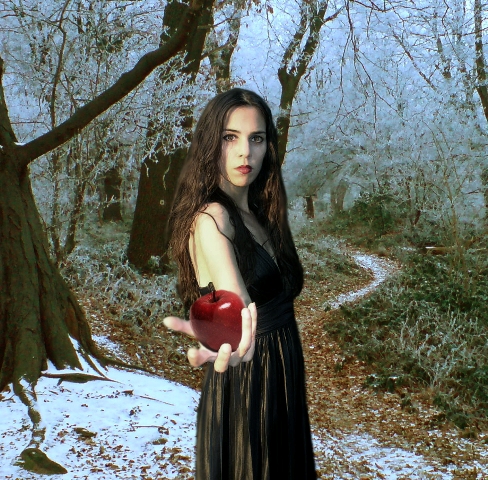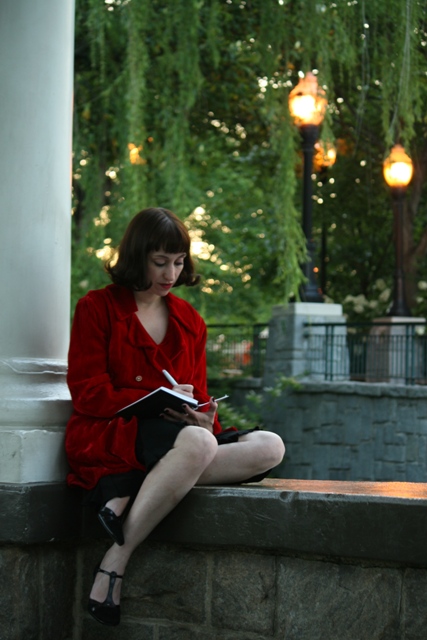
Carrie Anne Hunt as the Snow White Princess in Lisa Stock's play of Neil Gaiman's SNOW, GLASS, APPLES, which opens Aug. 24.
SNOW WHITE has a reputation for being a cheery story about a cute princess and seven mostly affable dwarves, but the only time I ever hid my eyes in a movie as a child was when the evil stepmother queen transforms herself into a hideous wicked witch in the Walt Disney version. Trust author Neil Gaiman (SANDMAN, AMERICAN GODS) to cleverly latch onto the darker side of that familiar tale and consider that mere jealousy might not be sufficient motive to drive the queen to murder by poisoned apple. And maybe the prince wasn’t exactly your normal kind of hero either. “I was reading Neil Philip‘s [PENGUIN BOOK OF] ENGLISH FOLKTALES, and a rereading of a version of SNOW WHITE made me stop and wonder what kind of person she was, and what kind of person sees a dead girl in a glass coffin and wants to keep her…,” Neil said in an email last week when asked what led him to write the short story, SNOW, GLASS, APPLES. Now Snow White’s white skin, blood-red lips and coffin-sleeping take on a new meaning with disturbing erotic implications, and the queen becomes a protagonist with a difficult moral choice.
Originally published as a benefit book for the Comic Book Legal Defense Fund in 1994, SNOW, GLASS, APPLES captured the imagination of so many readers that it was reprinted in two anthologies—TWICE BITTEN: LOVE IN VEIN II (1997), edited by Poppy Z. Brite, and Neil’s own collection SMOKE AND MIRRORS (1998). One of those readers was Lisa Stock, who like the storytellers of old, had her own thoughts about taking the tale in a new direction from page to stage. Through a few mutual friends, the then-New York-based writer/director for theater and film politely asked Neil nicely for a chance to have some fun with his story of bloodlust and mistrust. Charmed by her vision, the idea of seeing his creation come to life and the fact that all proceeds would benefit charity (East Atlanta Community Association), he granted her wish. “I love live theatre,” Neil said. “There’s a magic you cannot get from anything else when it’s good.”
While this real-life fairy tale so far may seem more CINDERELLA, it’s Atlanta audiences that really are the lucky ones. SNOW, GLASS, APPLES has its world premiere here Wed. Aug. 24 through Sun. Aug. 28 in the unusual venue of the East Atlanta Village Farmers Market, re-envisioned by Lisa as a dreamlike Spring Fair. Artists and photographers also will have a chance to draw and photograph cast members in costume and preview the phantasmagoric sets during a Dr. Sketchy’s Anti-Art School Atlanta field trip on Mon. Aug. 22. Performances are rated “R” for simulated violence and adult themes, but a special family-friendly show will be held Aug. 28 at 6 p.m.
ATLRetro recently caught up with Lisa to find out more about what drew her to the dark story, crafting a truly unique audience experience, why it’s the perfect fit for a Dr. Sketchy and a little about her other mythic projects, including the upcoming independent feature film TITANIA.
 For those unfamiliar with Neil Gaiman’s SNOW, GLASS, APPLES, without giving away too much, how is it different from the Disney version of SNOW WHITE we grew up with? And more like the original darker versions that date back to Medieval times?
For those unfamiliar with Neil Gaiman’s SNOW, GLASS, APPLES, without giving away too much, how is it different from the Disney version of SNOW WHITE we grew up with? And more like the original darker versions that date back to Medieval times?
For me, Neil Gaiman’s version reflects the earliest forms of the tale, some [of which] trace back to the myth of Persephone (eating pomegranate seeds and falling into a half-life in the Underworld). The tales were originally much darker in nature and true morality tales. SNOW, GLASS, APPLES for me is just that—a cautionary tale about trusting or mistrusting your instincts. It’s also about self-preservation in a brutal world, and how you deal with the choices that have been handed to you. Our protagonist doesn’t get saved and have all that’s hers by birthright returned to her. She makes her own decisions—for better or worse—and goes out to protect, on her own, what she holds dear.
How did you discover SNOW, GLASS, APPLES and what drew you personally to the story?
I discovered SNOW, GLASS, APPLES through a haunting illustration by Sarah Coleman of the princess that led me back to Neil’s story. I love new perspectives on old tales and those that speak to human instincts. Instincts are such a basic, fundamental part of being human, and yet we often ignore them. The Queen does that in this tale; I’ve done that more times than I can count. I’ve made mistakes, I’ve been defeated. We all have. And I think this short story brings out a side of us we may not want to own up to—it talks about fear and failure, but also responsibility and integrity. Though Neil has made the Queen the protagonist, she hasn’t lost any of her edge or her darkness. Instead, with the perspective in her corner, we recognize that in ourselves.
I also love all the visual reminders of her fear in the story: the vampiric princess who keeps coming back to life, the princess’ heart strung above her bed, the forest folk disappearing, nothing is as it seems, reminders to look deeper. Think about it. What are you afraid of? It takes up a lot of your time and space. That’s our nature. And in Neil’s story, the Queen goes out to do something about her fear; whether she’s successful or not, she tries to survive it. Was it the right thing to do or not—that’s for each of us to decide.
Read the rest of this entry »

